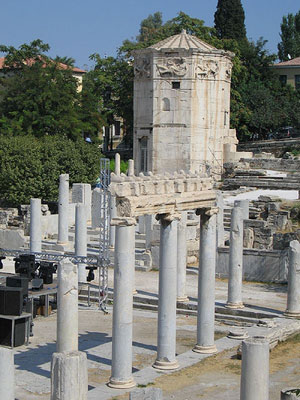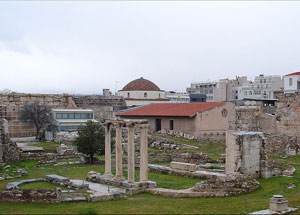

Ancient Athens - The Roman Agora of Athens
A small section of the ancient street leading from the Agora to the Agora of Caesar and Augustus (the Roman Market or Agora) with its southern colonnade is visible below street level on the right side of Rigillis street, beyond the gate. Between AD 98 and 102, when the Library of Titus Flavius Pantainos (donated by this self-styled priest of the philosophical muses) was constructed at the western end of the road running east-west from the Gate of Athena Archegetis of the Market of Caesar and Augustus to the Agora, this road was realigned and embellished at public expense. As it was reached by monumental stairways at each end it was meant for only pedestrian use. A simple monumental marble arch with a fountain was built at the road's western end, to balance the Gate of Athena Archegetis at its eastern end as well as to join the Library of Pantainos and the Stoa of Attalos. A single-storey Ionic colonnade or stoa on each side of the approximately 10 m wide marble-paved street served as a common facade for a variety of rooms with different plans. The exterior walls of the colonnade were covered in marble revetment. This colonnaded street represents one of the earliest examples of a major architectural feature in the cityscape of important Roman cities in the Empire. While most of the rooms were probably shops, one in the middle of the southern side (Room 3) appears to been used as a place of worship for the imperial cult, in particular, of Emperor Trajan. Tiberius Claudius Attikos Herodes of Marathon (in northeastern Attica; the father of the famous wealthy, sophist Herodes Attikos) is described as the high priest on one of the inscribed statue bases. Damaged in the Herulian raid on the city in AD 267 the entire complex continued to be in use as it was just inside the line of the Late Roman Fortification wall. During the 5th century AD a large, well-appointed complex (the Late Roman Building), was constructed using the southern colonnade with a second storey added to it. This area was inhabited continuously at least until the 8th century AD.
